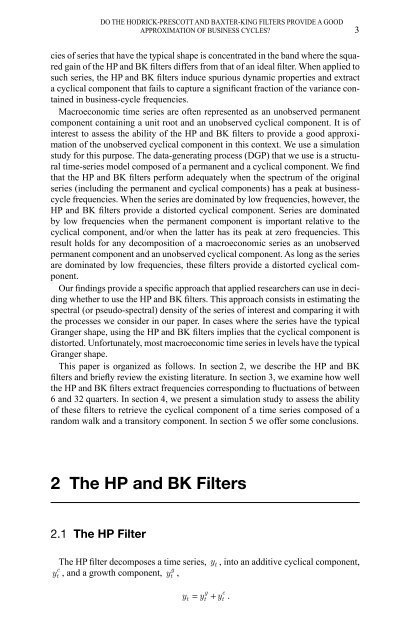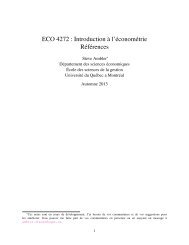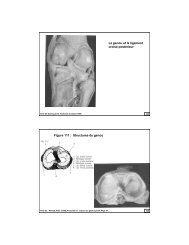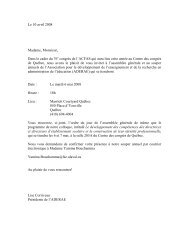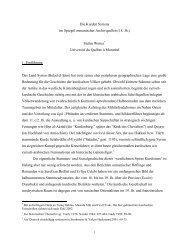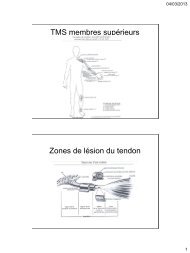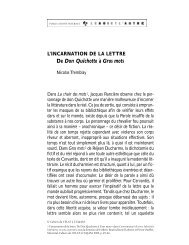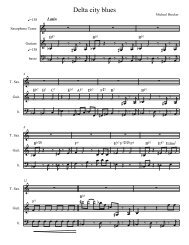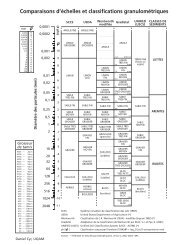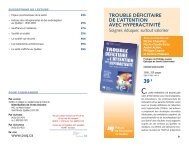Do the Hodrick-Prescott and Baxter-King Filters Provide a ... - UQAM
Do the Hodrick-Prescott and Baxter-King Filters Provide a ... - UQAM
Do the Hodrick-Prescott and Baxter-King Filters Provide a ... - UQAM
Create successful ePaper yourself
Turn your PDF publications into a flip-book with our unique Google optimized e-Paper software.
DO THE HODRICK-PRESCOTT AND BAXTER-KING FILTERS PROVIDE A GOOD<br />
APPROXIMATION OF BUSINESS CYCLES? 3<br />
cies of series that have <strong>the</strong> typical shape is concentrated in <strong>the</strong> b<strong>and</strong> where <strong>the</strong> squared<br />
gain of <strong>the</strong> HP <strong>and</strong> BK filters differs from that of an ideal filter. When applied to<br />
such series, <strong>the</strong> HP <strong>and</strong> BK filters induce spurious dynamic properties <strong>and</strong> extract<br />
a cyclical component that fails to capture a significant fraction of <strong>the</strong> variance contained<br />
in business-cycle frequencies.<br />
Macroeconomic time series are often represented as an unobserved permanent<br />
component containing a unit root <strong>and</strong> an unobserved cyclical component. It is of<br />
interest to assess <strong>the</strong> ability of <strong>the</strong> HP <strong>and</strong> BK filters to provide a good approximation<br />
of <strong>the</strong> unobserved cyclical component in this context. We use a simulation<br />
study for this purpose. The data-generating process (DGP) that we use is a structural<br />
time-series model composed of a permanent <strong>and</strong> a cyclical component. We find<br />
that <strong>the</strong> HP <strong>and</strong> BK filters perform adequately when <strong>the</strong> spectrum of <strong>the</strong> original<br />
series (including <strong>the</strong> permanent <strong>and</strong> cyclical components) has a peak at businesscycle<br />
frequencies. When <strong>the</strong> series are dominated by low frequencies, however, <strong>the</strong><br />
HP <strong>and</strong> BK filters provide a distorted cyclical component. Series are dominated<br />
by low frequencies when <strong>the</strong> permanent component is important relative to <strong>the</strong><br />
cyclical component, <strong>and</strong>/or when <strong>the</strong> latter has its peak at zero frequencies. This<br />
result holds for any decomposition of a macroeconomic series as an unobserved<br />
permanent component <strong>and</strong> an unobserved cyclical component. As long as <strong>the</strong> series<br />
are dominated by low frequencies, <strong>the</strong>se filters provide a distorted cyclical component.<br />
Our findings provide a specific approach that applied researchers can use in deciding<br />
whe<strong>the</strong>r to use <strong>the</strong> HP <strong>and</strong> BK filters. This approach consists in estimating <strong>the</strong><br />
spectral (or pseudo-spectral) density of <strong>the</strong> series of interest <strong>and</strong> comparing it with<br />
<strong>the</strong> processes we consider in our paper. In cases where <strong>the</strong> series have <strong>the</strong> typical<br />
Granger shape, using <strong>the</strong> HP <strong>and</strong> BK filters implies that <strong>the</strong> cyclical component is<br />
distorted. Unfortunately, most macroeconomic time series in levels have <strong>the</strong> typical<br />
Granger shape.<br />
This paper is organized as follows. In section 2, we describe <strong>the</strong> HP <strong>and</strong> BK<br />
filters <strong>and</strong> briefly review <strong>the</strong> existing literature. In section 3, we examine how well<br />
<strong>the</strong> HP <strong>and</strong> BK filters extract frequencies corresponding to fluctuations of between<br />
6 <strong>and</strong> 32 quarters. In section 4, we present a simulation study to assess <strong>the</strong> ability<br />
of <strong>the</strong>se filters to retrieve <strong>the</strong> cyclical component of a time series composed of a<br />
r<strong>and</strong>om walk <strong>and</strong> a transitory component. In section 5 we offer some conclusions.<br />
2 The HP <strong>and</strong> BK <strong>Filters</strong><br />
2.1 The HP Filter<br />
The HP filter decomposes a time series, y t , into an additive cyclical component,<br />
y , <strong>and</strong> a growth component, y ,<br />
c<br />
t<br />
g<br />
t<br />
g c<br />
t t t<br />
y = y + y .


